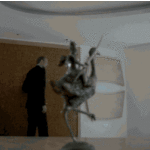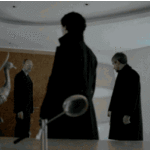So we’ve got a warrior with a sword (penis)
riding an ostrich (animal that buries its head in the sand)
Um, DBS? That’s not just a warrior. That’s a cherub.
That’s—well. Let’s take a closer look:
Huh. Interesting.
There are plenty of winged figures with swords in art history. Angels with swords have been around since Adam and Eve got kicked out of Eden. The most famous is Archangel Michael. But I don’t think we’re looking at ol’ Mikey, here. That’s not an adult face or body—Michael was always tall and ripped.
That’s a child.
So, a chubby kid with little wings. Hmm…
Oh hey, Cupid, a.k.a. Eros! God of Love and Desire? Fancy meeting you in a show about a totally platonic blokeship.
Such a coincidence.
Ah, Cupid. Our dear Bard sure had you pinned:
Love looks not with the eyes, but with the mind
And therefore is winged Cupid painted blind. (x)
I could be wrong. Maybe it’s not a cupid. There’s the helmet and sword. Later classical depictions of Cupid don’t really include helmets… except:
L’Enfant Guerrier, or Amour Guerrier—Child Soldier, or Warrior of Love. See, Cupid’s parents were Mars (god of War) and Venus (goddess of Beauty and Love). Mars is almost always shown wearing a helmet. It’s kind of his trademark. And sometimes Cupid liked to steal Dad’s stuff and cheekily play around.
(x)
The symbolism? Love is like War. Yeah, Pat Benatar sang ‘Love is a Battlefield’, but antiquity has been banging on that Love/War trope-drum since time immemorial.

So, back to our statue—he looks kind of serious. A helmet, a sword, a shield, no bow and arrows. Where’s our cuddly Valentine chibi? Cupids are supposed to be all mischievous sweetness and light and love-darts, right?
Well… not exactly:
(x)
As for the ostrich… I’m not really sure. Like the above excerpt said, Cupid/Eros has been depicted riding all kinds of beasties. Yes, Pliny the Elder gave us the iconic ‘ostrich with its head in the sand’ image; allusions to ignorance and denial are good points.
Let’s try going biblical, just for kicks. In the Bible, ostriches are depicted as tough, cruel, and stupid. (And as bad mothers, since they leave their eggs on the ground.) Also, as incredibly fast:
When [the ostrich] rouses herself to flee, she scorneth the horse and his rider. (x)I mean, really fast. Not even Xenophon’s ten thousand Greek troops in the Anabasis could catch them:
But no ostrich was captured by anyone, and any horseman who chased one speedily desisted; for it would distance him at once in its flight. (x)
Riding an animal is about harnessing its power. Let’s just assume the god of love and desire moves really damn quickly.
As an aside—there’s not a whole lot of artistic evidence of cherubs or cupids going into battle with swords. But there are the heroic putti of the Marienplatz in Munich:
There’s a whole convoluted political backstory behind the Mariensäule cherubs, but let’s just focus on the symbology.
Cherubs or putti aren’t always associated with Cupid and romantic love. Sometimes they’re guardian spirits, or the Roman genius: physical embodiments of invisible concepts or places, given personalities as they affect human lives.
Sometimes they stand for the omnipresence of God, or divine Providence, as they do here in Munich. Their shields bear epithets from Psalm 91:
Super aspidem et basiliscum calcabis conculcabis leonem et draconem
“The asp and the basilisk you will trample under foot
You will tread on the lion and the dragon.” (x)
Oh, yes. A dragon:
So, to review: the Appledore statue is probably a conquering Cupid—an angelic personification of the god of Love and Desire. Rides a fast steed, ready for battle, maybe sometimes slays dragons.
Now, one of the most well-known depictions of Cupid was painted by
my art history boyfriendCaravaggio:
Amor Victorious. Amor Vincit Omnia, or ‘Love Conquers All’. That’s the god of love trampling all over the symbols of science, reason, music, religion, and government. He throws everything into disarray. Caravaggio had a thing for the Roman poet Virgil:
Omnia vincit Amor: et nos cedamus Amori.
“Love conquers all; let us all yield [or surrender] to love!” (x)
Cupid can be vengeful and sassy. After Apollo (the seriously powerful god of reason and order, who was also quite gay) talks shit about him in Ovid’s Metamorphoses, Cupid retorts:
The child of Venus glanced at flush Apollo:
"Your arrows may be murder to us all,
But mine shall pierce your veins:
As much as mortals are less than the divine, so
Your glory is less than my poor skill.” (x)
The little dude’s retaliation began one of the most archetypal tales of passionate unrequited love in history.
The moral of the story? Love conquers all, and it can take down a god.
Oh, Sherlock, honey. You’ve got it all twisted. If classical antiquity has anything to say about it, you’re not on the winning side of this battle. Reason and logic won’t protect you. It’s only a matter of time.
Don’t mock the power of Desire; you will get the shaft.
… Yeah.
As for the production team question, I ascribe to the Arwel Wyn Jones Law: if it’s on the screen, we’re supposed to be looking at it.
~
Postcript: If anyone’s read this far(!) and wants to purchase their own version of the Appledore statue, Larry over at Bronze-Statues.com says they’ll be happy to knock off an extra 20% of the price listed online: (x).
If you’re in the UK, you can try your luck at Old Times Props: (x).
For more on ostriches, Edgar Williams wrote a great little book: (x)

Just another WordPress site






















